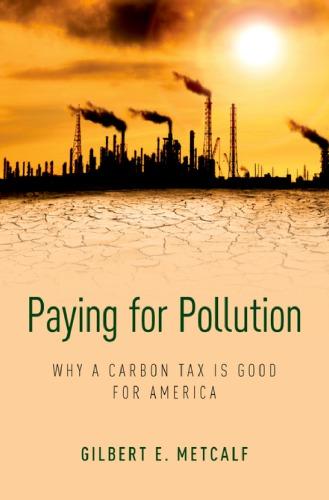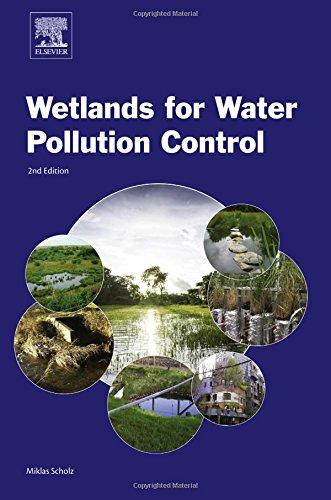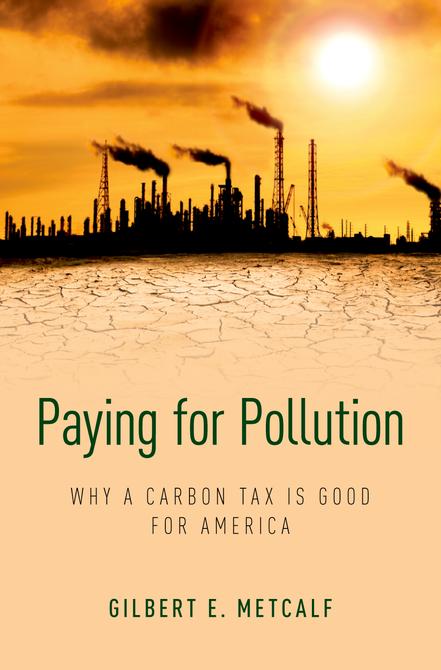Paying for Pollution
Why a Carbon Tax is Good for America
Gilbert E. Metcalf
Oxford University Press is a department of the University of Oxford. It furthers the University’s objective of excellence in research, scholarship, and education by publishing worldwide. Oxford is a registered trade mark of Oxford University Press in the UK and certain other countries.
Published in the United States of America by Oxford University Press 198 Madison Avenue, New York, NY 10016, United States of America.
© Oxford University Press 2019
All rights reserved. No part of this publication may be reproduced, stored in a retrieval system, or transmitted, in any form or by any means, without the prior permission in writing of Oxford University Press, or as expressly permitted by law, by license, or under terms agreed with the appropriate reproduction rights organization. Inquiries concerning reproduction outside the scope of the above should be sent to the Rights Department, Oxford University Press, at the address above.
You must not circulate this work in any other form and you must impose this same condition on any acquirer.
CIP data is on file at the Library of Congress
ISBN 978–0–19–069419–7
9 8 7 6 5 4 3 2 1
Printed by Sheridan Books, Inc., United States of America
For Simon and Calvin
CONTENTS
Preface ix
Introduction: Why This Book? 1
1. Climate Change: What’s the Big Deal? 7
2. Business as Usual: What Are the Costs? 23
3. Why Do Economists Like a Carbon Tax? 35
4. Isn’t There a Better Way? (No, There Isn’t) 53
5. Cap and Trade: The Other Way to Price Pollution 73
6. What to Do with $200 Billion: Give It Back 87
7. So You Want a Carbon Tax: How Do You Design It? 99
8. Objections to a Carbon Tax 115
9. Enacting a Carbon Tax: How Do We Get There? 129 What Next? 141
Notes 143
References 165
Index 177
PREFACE
According to Nathanial Hawthorne, “Easy reading is damn hard writing.” That is especially true when writing a book on a technical subject for a general audience. In writing this book, I have deliberately avoided the mathematical tools and conventions that economists fall back on in academic writing. Readers need not fear that they will see complicated equations, derivatives, stochastic calculus, or other high tech tools of modern economics. Instead, I have tried to write a book that is accessible to any person interested in the issue of climate change and in how our government should respond to this threat. I took this approach to reach as wide an audience as possible in hopes of influencing debate over climate policy. At the same time, I have provided extensive endnotes and references for readers who want to see the research that underpins this book.1
I have carried out research on climate change policy for roughly twenty years now. Nearly all of that work informs this book. I have benefitted greatly from conversations with Joe Aldy, Dallas Burtraw, Kelly Sims Gallagher, Marc Hafstead, Ted Halstead, Kevin Hassett, Captain William Holt, USCG, Ret., Chris Knittel, Ray Kopp, Henry Lee, Billy Pizer, John Reilly, Ricky Revesz, Rob Stavins, Jim Stock, Jerry Taylor, David Weisbach, and Rob Williams, among many others. They cannot be held responsible for any of the opinions I’ve expressed in this book. Those opinions are mine alone. Richard Forman, Jeff Greene, and Michael Klein have read drafts of this book and provided constructive suggestions for which I’m grateful.
I wrote most of this book while on leave from the Department of Economics at Tufts University. I spent some of that time as a visiting scholar at the MossavarRahmani Center at Harvard’s Kennedy School of Government. My thanks to Larry Summers for extending the invitation and to John Haigh and Scott Leland for making me welcome there.
I am also grateful for a grant from the Smith Richardson Foundation that supported my writing of this book including funding part of my leave. This book has benefitted from the thoughtful guidance of David Pervin, my editor at Oxford University Press, and the comments of two anonymous reviewers. Stefan Koester dug up data, factoids, old articles, and other useful material with impressive speed. Erika Niedowski was a superb copyeditor who helped shape and tighten my writing throughout the book. If this book is noteworthy for its readability, it is due in no small part to her exacting standards and close reading of the manuscript along the way.
Finally, I want to thank my wife, Rebecca Winborn, who has been a source of unwavering support throughout my writing of this book. She has shown great patience while I’ve been absorbed in this project. More than that, she reminds me every day that how we live our lives is a choice we each make; doing so in a deliberate way enriches us in many ways. I hope this book, in its own way, can help us as a society live more deliberately and enrich our world not just for ourselves but for future generations as well.
[ x ] Preface
Introduction: Why This Book?
The world is in the midst of a risky and unprecedented experiment. We are adding carbon dioxide and other greenhouse gases into the atmosphere at a prodigious rate, primarily from our burning of fossil fuels. By trapping heat in the atmosphere, these accumulated gases are pollutants that cause longlasting, pervasive damages from higher temperatures, more extreme weather, sealevel rise, and glacial melt, among other things. Those damages are costly, not only for those of us alive today, but also for our children and our children’s children. Carbon dioxide and other greenhouse gases linger for hundreds of years in our atmosphere. Like the proverbial frog in a frying pan, we need to jump out of the pan while there is still time to do so— that is, we must speed up the pace at which we move our economy away from a reliance on fossil fuels.
The best way for the United States to do that is to enact a national carbon tax. This may seem quixotic in our current political environment. But the problem is urgent and our efforts to date are not sufficiently aggressive to successfully deal with the problem. It’s time for a new approach.
Why is there an urgent need to act? Every month brings new reports of recordbreaking temperatures. But the problem goes well beyond high temperatures. Anyone following the news in the summer and early fall of 2017 could be excused for fearing that the apocalypse might be at hand. In August, Hurricane Harvey, a category 4 hurricane, stalled over Texas, dumping as much as sixty inches of water on the eastern part of the state. Parts of Houston, in Harris County, received over forty inches of paralyzing
rain. Nearly threequarters of the county was under at least one and a half feet of water, and the rebuilding will cost many billions of dollars.1
Category 5 Irma roared through the Atlantic on the heels of Harvey causing extensive damage in the Caribbean and Florida Keys only to be followed by Maria two weeks later. Maria, another category 5 storm, ravaged Puerto Rico, leaving the island’s population of 3.4 million almost entirely without electricity and other basic services. At the start of 2018, over half of the island was still without power.2
Then came devastating wildfires that burned thousands of acres in California, destroying over 6,700 homes and killing at least forty three people. Across the nation, over ten million acres of forest burned in 2017, making it one of the worst fire seasons ever.
The impacts of climate change go beyond immediate storm and fire damage. Climate change contributes to regional instability and conflict as well. Some researchers have linked the Syrian civil war to a severe drought most likely exacerbated by climate change. The drought—one of the worst in 900 years— spurred some 1.5 million people to migrate from rural areas to Syrian cities, cities that were illprepared for this massive influx. This destabilizing movement of Syrians put even greater pressure on the government to address domestic social problems. The spillovers from the Syrian conflict continue, with an outmigration of refugees that has put severe pressure on the European Union (EU) and added to tensions that contributed to Brexit, the United Kingdom’s vote to leave the EU.3
Climate skeptics are now having a tougher time dismissing these events, though that skepticism doesn’t change anything. As Neil DeGrasse Tyson puts it, “that’s the good thing about science: it’s true whether or not you believe in it.”
It’s not enough simply to recognize that climate change is a big problem. We must act. The United States is second only to China in emissions of carbon dioxide and so needs to play a key role in global efforts to reduce emissions. Our country, however, is shirking its responsibility to lead in this effort. Indeed, the current administration is backtracking on taking any commitments to reduce US emissions. Since then administrator of the Environmental Protection Agency (EPA) Scott Pruitt moved to withdraw plans to regulate carbon pollution from power plants, it is unlikely that the current set of policies will be sufficient to meet the US pledge made in Paris to reduce greenhouse gas emissions “26 to 28 percent below its 2005 level in 2025.” That pledge, of course, has little meaning given President Trump’s June 2017 announcement to pull the United States out of the Paris Agreement, an international agreement to reduce global emissions.4
We do have policies at the federal level to support clean energy production, such as solar and wind. But those policies are being actively undermined by the Trump administration. The decision to roll back the more stringent CAFE emission rules for cars and light trucks for model years 2022–2025 is just one more example of backtracking. And even if the policies weren’t being undercut, they are inadequate given the magnitude of the challenge we face.5
In an encouraging sign, states are stepping up to fill the breach. Coming together in response to Trump’s announcement to pull out of the Paris Agreement, the US Climate Alliance of seventeen states and federal territories now represents over one third of the US population. The alliance members pledged statelevel leadership on climate policy and committed to “showing the nation and the world that ambitious climate action is achievable.”6 There is precedence for such state leadership; under our federal system, states have long served as laboratories of democracy, testing ideas and approaches to governance.
Although state leadership is critically important, it is not a substitute for strong federal leadership, but we’ll have to do better at the federal level than we’ve done so far. Over the past thirty years or so, federal leadership has been a mix of inefficient regulatory mandates combined with assorted tax breaks for zero carbon energy production, while— to add to our policy incoherence— we continue to subsidize fossil fuel extraction. To paraphrase a quotation often attributed to Winston Churchill: “Americans will always do the right thing, only after they have tried everything else.” We have tried just about every policy to spur the growth of green energy except the most obvious and, as any economist will tell you, the most efficient: pricing pollution. When it comes to climate policy, pricing pollution is Churchill’s “right thing.” And now is the time to do it.
Why is a carbon tax the right response? Markets work best when the price of a good reflects all its costs. If the price of the good doesn’t include all the costs— the damages from pollution, for example— then we are effectively subsidizing that good and, as a result, will consume too much of it. Because we don’t include the costs of climate change in the price of fossil fuels, we consume more of them than is good for society. Taxing carbon aligns the price we consumers see with the true costs of using these fuels. It’s pretty simple. People respond to prices. If we raise the price of fossil fuels to reflect their true cost, consumption falls. When gasoline prices rise, people drive less and buy more fuelefficient cars. Lower carbon natural gas is burned to produce electricity in place of high carbon coal. Factories invest in more efficient furnaces to reduce their fuel combustion—and on
and on, in literally millions of decisions made by businesses and families across the country. That’s the power of the market at work.
Taxing our carbon emissions is the least expensive way for our economy to cut carbon pollution. Rather than write regulations for all the parts of the economy that use fossil fuels, we simply make fossil fuels more expensive to reflect the full cost of their use. Users of fossil fuels, from the owner of a big factory to the driver of a compact car, can adjust their behavior in response to the price of energy that includes the full price of carbon. There’s less waste with a price than with complex rules and regulations. A carbon tax brings to mind the slogan for the retail chain Target: “Expect more, pay less.”
In addition to the pocketbook argument for costeffective policy, there is a practical political argument. We will have greater success overcoming opposition to climate policy if we can reduce the policy’s costs. We won’t easily overcome opposition from groups negatively impacted by a carbon tax— owners of coal mines, for example. But we create unnecessary problems if we choose policies that are overly bureaucratic, are burdensome to comply with, and drive up costs for all Americans. As a corollary, moving away from our current emphasis on regulation, or command and control rules, as the principal tool of climate policy may resonate with those who favor a smaller, less intrusive federal government and less red tape. Recognizing that climate policy is inevitable, oil companies like ExxonMobil, Shell, and BP have come out in support of a carbon tax on the grounds that it would be better to have a simple, efficient policy like a tax rather than messy and inefficient regulations.7
If we’re going to have a carbon tax, we’ll need to decide what to do with the revenue. To avoid conflating climate policy with the question of how big the federal budget should be, a carbon tax should be revenue neutral: every dollar raised should be returned to taxpayers either through cuts in other taxes or cash grants. Republicans and Democrats have argued for years over the size of the federal government. It’s a contentious argument that should not ensnare carbon policy. Revenue neutrality is important for another reason. The opposition to a carbon tax is always framed as opposition to a standalone tax, rather than to a carbon tax at the center of a broader tax reform package. Our focus needs to be on a green tax reform rather than a carbon tax considered in isolation. Any tax is burdensome and an economic drag on an economy; a carbon tax is no different. Given the need to pay for important federal services, including defense, an interstate highway system, and Social Security, however, taxation is inevitable. It makes more sense to tax things we don’t like (e.g., pollution) than things we do (e.g., employment and saving). Revenue from a carbon tax
could be used to finance reforms to the corporate or personal income tax that improve the fairness of the tax code and contribute to economic growth. But there are other ways we could use the revenue to benefit every US household without expanding the federal budget. We’ll need a framework for thinking about how to return carbon tax revenue to households. That’s a topic I address in Chapter 9.
Greening our tax code would also better align the United States with other major developed countries. The Organization for Economic Cooperation and Development (OECD), a club of thirty five countries with marketbased economies, tracks various fiscal measures of its member countries. Among the member countries, the United States collects the smallest share of its taxes from environmental taxes. In fact, most of the twenty one nonOECD countries that the OECD tracks also rely more heavily on environmental taxes than the United States.8
Finally, here is one more reason for this book. Our government is in a state of near paralysis with a level of political polarization unseen since, perhaps, the Civil War. We desperately need leadership that can bridge the divide between the two parties and return us to an era where disagreements were hammered out in a spirit of common good. In writing this book, I have focused on arguments that can appeal across the political spectrum. Using a marketbased instrument to address an environmental problem should appeal to those who want less government. A carbon tax could be the basis of a bipartisan compromise that resonates with both Democrats and Republicans. And who knows, maybe we can even restore some faith in our politicians as they demonstrate that they can tackle the big problems facing our country in the twenty first century.
CHAPTER 1
Climate Change: What’s the Big Deal?
Roxy Moore, age seventy, turns on her kitchen tap to fill her coffee pot. No water comes out. The well on her rural New Hampshire property has run dry for the first time in the thirty three years she has lived here. Bottled water is stacked on tables and in corners of her small, one story house. Roxy ticks off the problems: “You can’t do laundry, you can’t do dishes, you can’t flush the toilet, you can’t take a bath, you can’t clean your house, you can’t do anything you’re accustomed to doing.” With no money to dig a deeper well, she is resigned to the situation. “It is what it is, you know. You’ve got to learn to live this way until God gives us rain.”
A hundred miles south in Rochester, Massachusetts, Dawn Gates Allen, a fourthgeneration cranberry grower, prepares to dry harvest her cranberry crop. In a normal year, cranberry growers flood their fields and gather the floating berries with booms. Wetharvesting a twoacre field takes fifteen to twenty minutes. Dry harvesting the same field takes two to three days, requires expensive machines, and results in a loss of 10–15 percent of the crop. The last time Gates Allen dry harvested a cranberry crop was over forty years ago when she was a young girl helping her grandparents on the farm. Surveying one of her fields, a bed of cracked and dry mud flats with exposed tree roots, Gates Allen says, “It looks like a true swamp. It’s hauntingly eerie.”1
DROUGHTS AND OTHER EXTREME WEATHER
These examples highlight the impact of drought conditions affecting the northeastern states in the summer of 2016. By the end of that summer,
over half of Massachusetts was in “extreme drought” conditions, the second highest of four drought designations described by the US Drought Monitor. The nearly five million affected people had never experienced such conditions since the Drought Monitor began collecting data in 1999.2 Across Massachusetts, farmers reported over $13 million in crop losses. Impacts were wideranging. Farmers in western New York suffered with fires during straw removal from their fields. State extension expert Robert Hadad commented that “the two and fourlegged critters are more voracious when it’s this dry. We are seeing lots of damage in new sweet corn from geese. Deer are eating everything else. It’s ugly!”3 Meanwhile, Maine beekeepers reported that many beehives in the state did not produce sufficient honey to survive the coming winter.4 This could have knockon effects on agriculture in New England given the importance of honey bees for pollination for many crops and fruit trees. The drought in the Northeast was unusual: according to the Drought Monitor, the extreme drought conditions are a oncein twenty to oncein fifty year event.
Depending on who you ask, California’s recent drought began in 2012 or 1999, or it is the most recent episode of a “megadrought” going on for decades. Regardless of when it started, it has been devastating. In 2016, nearly two thirds of Californians—over twenty three million people— experienced extreme or exceptional drought, the two highest drought ratings, and economists at the University of California, Davis (UC Davis) estimated that droughtrelated costs drained over $600 million from state farmers. This is good news, relatively speaking, as costs were $2.7 billion in 2015, when the drought was even more severe. Farmers left nearly eighty thousand acres of farmland fallow in 2016 due to a lack of water; this idled land led to some $250 million in lost revenue and a loss of over eighteen hundred jobs. Farmers also incurred $300 million in additional costs to pump groundwater to replace surface water lost from the Central Valley and State Water Projects.5
Meanwhile in the south, residents of Livingston Parish in Louisiana watched onceburied coffins float through the streets after more than twenty five inches of rain fell in a threeday period in August 2016, flooded the parish, and saturated the local cemetery. The Louisiana deluge is an example of a fivehundred year rainfall event: the probability of a storm of this magnitude in the state in any given year is 1/500 or 0.2 percent. But this was the eighth fivehundred year rainfall event in the United States in just four months, suggesting an increase in the frequency and severity of such storms.
Just a few months earlier, the “Tax Day Flood” of April 17–18, 2016, had killed at least seven people and destroyed some 6,700 homes in the
Houston, Texas, metropolitan area.6 Some communities experienced seventeen inches of rain in the twoday period and the Harris County Flood Control District estimated that 240 billion gallons of water fell during the storm.7 That’s enough water to fill fifteen bathtubs for every man, woman, and child in the United States.8 It seemed like a lot, until Hurricane Harvey stalled over Texas the following year and, in four days, dumped a trillion gallons of water on the county in which Houston sits. That’s sixty bathtubs worth of water per person in the United States or as much water as flows over Niagara Falls in fifteen days. Overall, Harvey dumped thirty three trillion gallons of water on Texas, Louisiana, Tennessee, and Kentucky— enough to cover the state of Arizona with nearly one and a half feet of water.9
After enduring over five years of recordbreaking droughts, California was pummeled with heavy rainfall and snow in early 2017. Snowpack in the winter of 2017 was over 70 percent higher than average, and the state’s reservoirs were over 20 percent fuller than average. Even if the drought is over, its effects will linger as over one hundred million trees have died since the drought began and groundwaters have been depleted. “The groundwater drought is likely to linger for quite some time,” observed Jay Lund, a water expert at UC Davis, “in some areas possibly permanently.”10 Depleted groundwater has longlasting and, perhaps, permanent costs. As groundwater is depleted from an aquifer, the land can settle or “slump like a punctured air mattress,” as one climate scientist described it. Parts of the western edge of the Central Valley, California’s major agricultural region, which depends heavily on groundwater for irrigation, “have sunk by nearly thirty feet since the nineteen twenties” putting roads, bridges, and other local infrastructure at risk.11 Groundwater aquifers are a savings bank for California farmers that can sustain them during periods of low rainfall and drought. But the system can’t function effectively if Mother Nature doesn’t make occasional deposits to the bank. Aggravating the problem is the fact that land subsidence due to groundwater depletion reduces the amount of storage space for underground water and so diminishes the ability of the water bank to recover over time.
Climate change only makes this situation worse. California’s water system depends heavily on winter snowpack to store water for gradual release in the spring and summer. The state’s water infrastructure of dams, canals, and reservoirs was designed to take advantage of a large winter snowpack that would store and gradually release water throughout the year. But as more precipitation occurs in the form of rain rather than snow, the snow pack will over time be smaller and will melt more rapidly and so
subject future generations of Californian farmers and residents to more frequent spring time floods and summer time droughts.
California’s recent swing from drought to flood conditions is just one example among an increasing number of extreme weather events in the United States. Such examples of unusual weather events are helpful for visualizing the impacts of climate change. But what is extreme weather? Climatologists define extreme weather event days days with very high temperatures, heavy precipitation, longlasting drought, frequent tornados, and so on—as days that occur very infrequently. For example, consider a county that has experienced a June day with a maximum daily temperature of 100 degrees or higher fewer than ten times over the past 100 years. Climatologists might then say that this county experienced an extreme weather event on any day in June that the temperature exceeds 100 degrees, since a June day hotter than 100 degrees has occurred less than 10 percent of the time in the historic record.
This is the idea behind the Climate Extremes Index (CEI) devised by the National Oceanic and Atmospheric Administration (NOAA), which tracks the frequency of extreme weather events, defined as a day with weather conditions that occur less than 10 percent of the time in the historic weather record tracked at tens of thousands of locations across the United States. The index tracks days that are unusually hot or unusually cold and also tracks drought and extreme precipitation events. It then combines this information into a summary index of extreme events for the United States, ranging from 0 to 100. In a given month, if there are no locations with extreme weather events, the index for that month is zero; if every location has an extreme weather event during the month, the index for that month equals one hundred.
If conditions in a given month follow historic patterns, the CEI will equal twenty. Occasionally the index is lower than twenty as in 1970 when it dropped to eight. And occasionally it spikes, as it did in 1934 when the index topped thirty eight. But what is notable is that the top three years for extreme climate were 2012, 2015, and 2016 with index values of fiftytwo, forty three, and forty four, respectively. To put this in perspective, an index value of fifty two for a given year means the United States is more likely to experience a day with extreme weather than a flipped coin is likely to land with heads up.
It is easy to point to examples of unusual heat spells or floods in the past few years. But for purposes of detecting climate change, trends over time are more relevant—and more troubling. The NOAA’s Monthly Climate Update has been tracking temperature and precipitation since 1895. Its data show a clear trend toward hotter weather. Six of the ten hottest years
on record for the continental United States have occurred since 2000 with the three hottest years occurring in 2012, 2016, and 2017. Seven of the ten hottest summers have occurred over this same period, with the summers of 2011 and 2012 surpassed only by the Dust Bowl summer of 1936.12
The Dust Bowl is a perfect example of extreme weather, given the combination of high temperatures and drought conditions experienced in the Midwest during the 1930s. In 1935 alone, hot, dry winds blew some 850 million tons of topsoil from over four million acres of land—enough topsoil to bury Manhattan to a depth of thirty feet. By 1938, an estimated ten million acres had lost five inches of topsoil and another 13.5 million acres had lost two and a half inches. It is difficult to quantify the economic and social costs of the Dust Bowl, but a few statistics give a sense of its magnitude. Farmland values fell by 30 percent in higherosion counties in the 1930s and by 17 percent in counties that experienced less severe erosion. That translates into an economic loss of roughly $35 billion in today’s dollars. The loss in land value was only partially recovered over the next several years, and that only came about through a massive out migration of population as many of the small farmers abandoned their homes and livelihoods in an exodus graphically portrayed in John Steinbeck’s The Grapes of Wrath. As many as one in eight residents of counties that experienced high erosion is estimated to have moved away in search of better economic opportunities. The US experience of the Dust Bowl is a grim reminder of the potential for economic dislocation and social upheaval as climate patterns change in different parts of the world—and as we are already seeing in parts of Africa and the Middle East.13
Droughts, floods, and extreme temperatures are very serious. But there are even bigger concerns. Scientists are increasingly focused on abrupt and irreversible major changes— what one might refer to as catastrophic events. These include such events as the complete loss of the Greenland ice sheet or the West Antarctic ice sheet. The Greenland ice sheet is two miles deep at its center and its mass “is so great that it deforms the earth, pushing the bedrock several thousand feet into the mantle. Its gravitational tug affects the distribution of the oceans.”14 It is akin to a massive bucket of ice precariously perched on the rim of a glass of water. Drop the ice into the glass and the water rises. The complete loss of the Greenland ice sheet would raise sea levels by over 22 feet, a sea level rise that, in the absence of any steps to protect themselves, would entirely inundate a number of major cities including Norfolk, Virginia, home of the largest naval complex in the world. Even more cities would be partially flooded. Over threequarters of Savannah, Georgia, would be flooded and even Washington, DC, would be partially flooded, with the complete flooding of Reagan National Airport
and, across the Potomac from the airport, US Joint Base AnacostiaBolling (formerly the Anacostia Naval Support Facility and the adjoining Bolling Air Force Base).15
Meanwhile in Antarctica in early 2017, scientists began tracking a growing crack in the Larsen C ice shelf. The crack extended to over a hundred miles long and was growing at a rate of five football fields a day. In July, a giant iceberg the size of Delaware and capable of covering the United States in nearly five inches of ice broke off the ice shelf and drifted off into the Southern Ocean where it will eventually break up into smaller bergs.16 This floating berg will not itself raise sea levels, since the ice shelf was already floating in the ocean. But it removes a cork, in the words of Eric Rignot, a glaciologist at the University of California, Irvine (UC Irvine), which is holding back landbased glaciers that would raise sea levels should they break up and slide into the seas around Antarctica.
Other concerns include the sudden release of massive amounts of methane (a potent greenhouse gas) locked up in ice formations in Arctic permafrost, that is, permanently frozen soil. Methane release is an example of a vicious spiral where higher temperatures lead to permafrost melt and methane release which, in turn, lead to even higher temperatures, more melt and methane release, and so on. Especially worrisome are the very large amounts of methane locked up in permafrost and ocean seabed formations (so called clathrates), given methane’s much more potent global warming impacts relative to carbon dioxide— some thirty four times more over a century.17
Such changes are hardly limited to the United States, and evidence from throughout the world reinforces confidence in the fact that climate change is not only happening but accelerating. Each of the past three decades has set a record for global average temperatures with the global average temperature increasing by one degree Celsius since 1900.18 Land temperatures are rising, as are sea temperatures.
A onedegree temperature increase doesn’t seem like a big deal. But consider the Great Barrier Reef, the largest structure made by living beings on the planet—larger than the states of Wisconsin and Minnesota combined. Reefs are constructed by corals, tiny tube shaped animals that live in colonies in the reefs. The Great Barrier Reef corals feed on photosynthesizing algae that they capture and maintain. The algae, however, are highly temperature sensitive and produce toxins in response to higher temperatures. Corals respond by expelling the algae and then turn white, a phenomenon known as coral bleaching. If the temperature drops, the corals can gather new algae and recover. If the temperature stays high enough for long enough, they will die. Record temperatures in 2015 and 2016 have led to
the third occurrence of mass coral bleaching in the Great Barrier Reef since 1998.19
The most recent high temperatures at the Great Barrier Reef led to onethird of the corals being exposed to between fourteen and thirty degree heating weeks (Fahrenheit). A measure of fourteen degree heating weeks means an ocean area experienced some combination of higher temperature for a number of weeks (e.g., two degrees Fahrenheit above normal for seven weeks or one degree above normal for fourteen weeks). Scientists estimate that an exposure of fourteen degree heating weeks will lead to 80 percent of reefs experiencing coral bleaching, and thirty degree heating weeks will lead to near 100 percent bleaching. Global sea temperatures have increased by about 1.5 degrees Fahrenheit since the end of the nineteenth century, with the temperature increase higher in tropical areas. The concern is that more frequent and intense bleaching episodes will kill off the coral permanently. Even if coral populations recover, slower growing coral will be crowded out by faster growing coral, leading to diminished diversity of coral populations in tropical reefs. However you may feel about coral, keep in mind that the Great Barrier Reef supports some seventy thousand tourism jobs in the region and creates billions of dollars of economic activity in northeast Australia.20
Rising sea temperatures contribute to the melting of both sea ice and landbased ice, and the implications of rising sea levels are among the most troubling. While the negative impacts of climate change are most often the focus of attention, there can be localized benefits as well. Melting sea ice in the Arctic Ocean means the Arctic waters will become navigable over longer periods of time, thereby opening new sea routes and potentially shortening transit times. This melting also opens this region to new economic activity including increased fishing, oil and gas drilling, and undersea mineral extraction.
These economic benefits have led to an Arctic land rush. Russia, for example, staked a claim in 2015 to nearly half a million square miles of the Arctic Ocean including the sea bed under the North Pole, an area larger than the combined areas of Texas and California. If accepted, this claim would give Russia control over all economic activity there including fishing, mining, and oil and gas drilling. Russia is not alone in this Arctic “land” rush: Canada, Norway, and Denmark have also filed claims to areas in the Arctic region.21 But let’s be clear. The existence of localized benefits should not lull us into inaction. Offsetting any benefits of Arctic ice melt are the costs of disruptions to animal habitats and the destabilization of the economies of local indigenous people. Melting sea ice also has implications for national security. As Secretary of Defense James Mattis told Congress
during his confirmation hearings, “the Arctic is key strategic terrain . . . . Russia is taking aggressive steps to increase its presence there. I will prioritize the development of an integrated strategy for the Arctic.”22
Melting Arctic ice has no impact on sea levels for the same reason that a melting ice cube in a glass of iced tea does not raise the level of tea in the glass. Melting glaciers, which are based on land, do on the other hand, contribute to sealevel rise, just as adding additional ice cubes will raise the level of the tea. The evidence is that glaciers across the world are shrinking, which means that an increasing amount of water is eventually reaching the seas. The best estimates are that since 1971 there has been an average iceloss of 226 billion metric tons per year. The rate of loss is accelerating and now tops 301 billion metric tons per year, enough ice to bury the state of Kansas five feet deep.
That is a lot of ice cubes. To say that the seas and oceans are like big glasses is to state the obvious. Nonetheless, since the beginning of the twentieth century, global average sea levels have risen by roughly eight inches, with the rate of rise increasing in recent years. Depending on global emissions of greenhouse gases over this century, the global average sea level could rise between one and two feet in the best case scenario—over three feet in the worst case scenario—making coastal areas more vulnerable to land erosion and flooding.23 In the United States, over half the population lives near the coast and over half of our economic activity is generated in coastal areas.24
Hurricanes Katrina and Harvey illustrated the vulnerability of coastal cities to major storms and the impact of flooding on low lying areas. How future sea level rise will affect coastal areas depends critically on how well we can adapt. Adapting will require investment in infrastructure that is resilient to the impacts of more intense coastal storms, rising sea levels, and higher temperatures. Climateresilient infrastructure includes such things as more durable seawalls, elevated highways in some areas, land set asides for wetland preservation, and other costly investments. Adaptation will also require our putting systems in place to protect the urban poor, who tend to congregate in the most vulnerable areas in coastal cities, and fixing the mispricing of coastal and flood insurance, which doesn’t accurately reflect the risks of living in coastal areas.25
CLIMATE CHANGE OR WEIRD WEATHER?
The first Alaskan forest fire of 2016 broke out in February with a second one following eight days later. In contrast, the first forest fires in 2015 didn’t start until May.26 By April 2016, New Mexico had experienced twice
as many fires as in the whole of the previous year. Meanwhile that same month, the New York Times reported that fires along the Colorado River between Arizona and California were burning so intensely that flames were leaping over the river, forcing an evacuation of two RV parks.27 The early start to the fire season in 2016 was a sign of the increased severity and duration of wildfires. By one measure— the elapsed time between the first and last large fire in a year— the fire season in the West has increased by seventy eight days since the 1970s. The 10 million acres burned in the United States in 2015 were the most burned in any year since the 1950s.
Meanwhile, 2017 shaped up as one of the worst forest fire seasons ever recorded. By midOctober, over 8.8 million acres had burned and over 10,000 firefighters were struggling to bring six large fires in California under control. At its peak, over 25,000 firefighters, National Guardsmen, and activeduty soldiers were fighting the blazes. The October fires in California damaged or destroyed over 21,000 homes, 2,800 businesses, and 6,100 motor vehicles. Even more tragic, forty three people died. The California Department of Insurance reports more than $9.4 billion in insurance claims for those fires.28
Wildfires have clear costs to taxpayers and nearby residents. US Forest Service fire suppression costs alone topped $2.7 billion in 2017, making it the most expensive firefighting year on record. In the United States, twice as much acreage burns now as did thirty years ago, and the six worst fire seasons since 1960 have all occurred since 2000. Indeed, some of the western states have recently witnessed the largest wildfires they have ever seen. The increased size and severity of fires has consumed an evergrowing share of the US Forest Service budget. Whereas 16 percent of the Forest Service budget was spent on wildfire costs in 1995, over half of its $6.5 billion budget in 2015 was devoted to wildfirerelated costs. US Secretary of Agriculture Sonny Perdue noted that “we end up having to hoard all of our money that is intended for fire prevention, because we’re afraid we’re going to need it to actually fight fires. It means we can’t do the prescribed burning, harvesting, or insect control to prevent leaving a fuel load in the forest for future fires to feed on. That’s wrong, and that’s no way to manage the Forest Service.”29
The rising cost of fighting fires is putting pressure on the Forest Service budget. But suppression is just one of the costs of wildfires. Loss of homes and tax revenues, rehabilitation, and other costs in the aftermath of a fire raise the total cost. An analysis of six wildfires since 2000 shows that the total costs can be many multiples of the costs of firefighting alone. A 2003 fire in the Santa Ana watershed of Southern California illustrates the additional costs. While fire suppression itself cost $61 million, homeowner and
business losses, land rehabilitation, and water costs drove the total costs of the fire to $1.2 billion—roughly twenty times the cost of suppressing the fire.30
The key question is not whether wildfires are more common now. Rather it is whether this spike in fires is a fluke or a sign of climate change. This is a core question for scientists. Climate change refers to longer term, permanent changes in temperature, precipitation, and other climatic conditions. What complicates detecting the longrun permanent changes in climate are shortrun weather fluctuations. But scientists are making progress in disentangling the impacts of climate change from those due to random weather fluctuations. One study finds that humaninduced climate change was responsible for over half of the increased forest fires in the western United States since 1970 and for an increase in burned areas since 1984 equal to the combined areas of Massachusetts and Connecticut. Climate change, the authors of the study concluded, also added nine additional days, on average, of high fire potential in the West.31
THE KEELING CURVE
The increase in forest fires is one indicator of the impact of our continued burning of fossil fuels. The greenhouse gases released as we burn fossil fuels linger in the atmosphere for decades and even for centuries. Since climate change results from that atmospheric buildup of gases, it makes sense to measure and track that accumulation over time. The Keeling Curve does precisely that.
In 1958 a young scientist named Charles (Dave) Keeling stood on the upper slopes of the Hawaiian volcano Mauna Loa, over 11,000 feet above sea level, inspecting his newly installed carbon dioxide monitoring equipment. Starting in March of that year and continuing to this day, Keeling’s equipment has silently sniffed the air hourly and recorded carbon dioxide concentrations.32 Long before climate change became a focus of many scientists, Keeling understood the importance of accurately measuring the accumulation of carbon dioxide in the atmosphere. His former colleague, John Chin, recalled, in a New York Times profile, “the painstaking steps he took, at Dr. Keeling’s behest, to ensure accuracy. Many hours were required every week just to be certain that the instruments atop Mauna Loa had not drifted out of kilter.”
Nor was Keeling’s passion for detail and precision limited to the instruments. His son Ralph recalls mowing the lawn as a young boy and his father instructing him to edge the lawn to exactly two inches. “It took
a lot of work to maintain this attractive gap,” Ralph recalled, but his father believed “that was just the right way to do it, and if you didn’t do that, you were cutting corners. It was a moral breach.” The scientific result of Keeling’s meticulousness is sixty years of continuous data, unchallenged by other scientists.33
Keeling’s climate record is even more impressive when you consider how sensitive his equipment had to be. Greenhouse gases accumulate in the atmosphere where they persist for decades or centuries depending on the gas. It is the stock of gases that matters for thinking about climate impacts and damages. The stock of gases in the atmosphere is a bit like the money in a savings account that was deposited in steady increments over time. Each year as fossil fuels are burned, we add to the stock of gases in the atmosphere just as annual deposits add to a savings account’s balance over time.
The stock of greenhouse gases in the atmosphere is measured as the amount of carbon dioxide in parts per million (ppm). Preindustrial age concentrations of carbon dioxide in the atmosphere averaged around 280 ppm. At 280 ppm, the amount of carbon dioxide contained in an empty Olympic size swimming pool would fit in a three foot square box just over two and a half feet high.
The concentration of carbon dioxide in the atmosphere has steadily grown since Keeling began taking measurements. By the time he installed his equipment on the Hawaiian volcano, in 1958, concentrations had already grown from 280 ppm—at the end of the nineteenth century— to 315 ppm, and that box, three foot square and just over two and a half feet high had grown to just over three feet high. By 2018, concentrations topped 406 ppm, and the box is now nearly four feet high. That inexorable upward trend over the past sixty years that has taken us over the 400ppm threshold is illustrated in figure 1.1 in what has come to be called the Keeling Curve.
The Keeling Curve illustrates another important feature of the earth’s atmosphere: its distinct sawtooth pattern demonstrates the atmosphere’s sensitivity to natural and human activity. Because trees and plants, disproportionately located in the Northern Hemisphere, absorb more carbon dioxide as they grow, there is a reduction in atmospheric carbon dioxide levels during the Northern Hemisphere summer months. This is represented in the valleys in figure 1.1. In the winter, plants go dormant and absorb less carbon dioxide, indicated by the peaks. After Keeling and his coauthors showed, in 1996, that the sawtooth pattern of carbon dioxide concentrations was becoming more pronounced, climate scientist Rhys Roth remarked that the earth is “breathing deeper.”34 While the sawtooth pattern is interesting, it is the sharp upward trend of the curve that is especially worrying.











